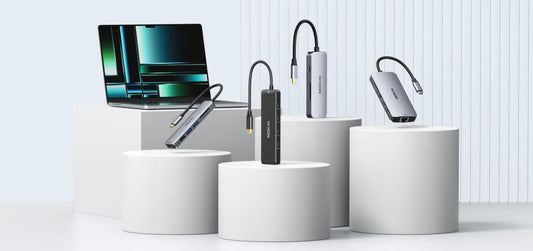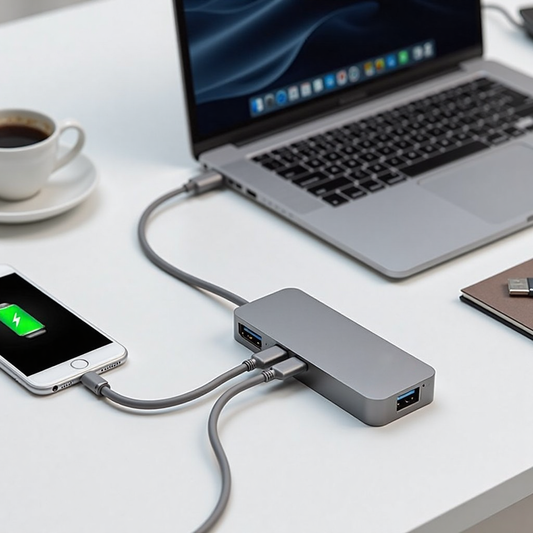How to Choose a USB Hub for Your Laptop: Key Considerations
Contents
As the digital workspace continues to evolve, the number of peripherals we use on a daily basis—such as keyboards, mice, USB drives, external hard drives, wireless adapters, card readers, and printers—keeps growing.However, many modern business laptops are designed with a limited number of ports, making it challenging to connect multiple devices simultaneously and hindering productivity. In such scenarios, having a versatile and efficient USB hub is crucial for professionals.
This guide will walk you through the six key factors you need to consider to choose a USB hub that truly expands your capabilities without compromising on performance or reliability.
#1 Understanding Upstream and Downstream Ports
Upstream Ports:
USB hubs come in two main types based on the physical appearance of the upstream port: USB-A and USB-C hub. It's important to match the hub's upstream port with the type of port on your laptop.
Downstream Ports:
These are the multiple ports you use to connect your peripherals (keyboards, drives, etc.). Beyond the quantity, also consider the mix of port types (e.g., USB-A, USB-C, HDMI, Ethernet) to match your devices.

#2 The Importance of a Dedicated Power Supply
A USB hub with a dedicated power supply can support high-capacity drives (up to 16TB) and other power-hungry devices. If you frequently use external hard drives or need to charge your phone/tablet, opt for a hub with a dedicated power supply.
Docking Station series expansion docks are generally equipped with exclusive power cables to provide sufficient power to the device.

#3 Speed Considerations
USB2.0: Offers a theoretical maximum speed of 480Mbps (60MB/s).
USB3.0: Provides a significant boost with a theoretical maximum speed of 5.0Gbps (625MB/s), which is 10 times faster than USB2.0. USB3.0 is backward compatible with USB2.0 devices. If speed is a priority, consider a USB3.0 hub.
For the highest performance, look for hubs supporting USB4 or Thunderbolt™ protocols. These are especially crucial if you need to connect high-resolution displays, fast external storage (NVMe SSDs), or an external graphics card. They offer dramatically increased data transfer speeds (typically 20-40 Gbps) and support advanced features like dual 4K display output from a single cable. Remember, while a USB-C port is physically universal, its underlying capabilities depend on these protocols.
| USB Version | Theoretical Maximum Speed | Speed Rating | Maximum Power Output |
|---|---|---|---|
| USB1.0 | 1.5Mbps (192KB/s) | Low-Speed | 5V/500mA |
| USB1.1 | 12Mbps (1.5MB/s) | Full-Speed | 5V/500mA |
| USB2.0 | 480Mbps (60MB/s) | High-Speed | 5V/500mA |
| USB3.0/USB3.1 Gen1/USB3.2 Gen1 | 5Gbps (500MB/s) | Super-Speed | 5V/900mA |
| USB3.1 Gen2/USB3.2 Gen2x1 | 10Gbps (1280MB/s) | Super-Speed+ | 5V/3A |
| USB3.2 Gen2x2 | 20Gbps | SuperSpeed+ USB dual-lane (20 Gbit/s) | 5V/3A |
| USB4 | 40Gbps | 40 Gbit/s (2-lane) | 5V/3A |
Making an informed decision requires a clear understanding of connectivity standards. For a deeper dive, our comprehensive Guide to Ports and Protocols decodes the specifications to ensure your hub meets the needs of all your devices.
#4 The Role of the Chipset
The chipset, or bridge chip, is the heart of a USB hub. It manages the distribution of resources from the laptop's single USB port to the multiple ports on the hub. The chipset's performance directly affects the hub's compatibility and the stability of connected peripherals.
#5 Cable Length
Short Cables (0.3/0.6m): Ideal for laptop users, as they are easy to carry and store.

Long Cables (1.2/2/3m): Better suited for desktop users, allowing the USB ports to be within easy reach.

#6 Aesthetic and Material Choices
USB hubs are available in various materials, including premium aluminum, plastic, and even tempered glass. The choice of material and design can affect the price, so select one that aligns with your personal preferences.
Your Quick-Check List Before You Buy
- ✅ Connection: Does the upstream port (USB-A/USB-C) match my laptop?
- ✅ Ports: Do I have enough downstream ports, and are the right types (USB, HDMI, Ethernet) available for my devices?
- ✅ Power: Will I be using power-hungry devices? If yes, a dedicated power supply is a must.
- ✅ Speed: Does the hub support USB 3.0 or higher to avoid slowing down my external drives?
- ✅ Use Case: Is the cable length and form factor (portable/desktop) suitable for my primary workspace?
Conclusion
In conclusion, a USB hub not only addresses the issue of limited laptop ports but also protects the native ports and supports OTG (On-The-Go) functionality, enabling a range of new possibilities when used with smartphones and tablets. By choosing the right USB hub, you can significantly enhance your productivity and the overall experience of using your devices.

MOKiN 13-IN-1 USB-C Laptop Charging Station with 2.26-inch LCD Smart Display








